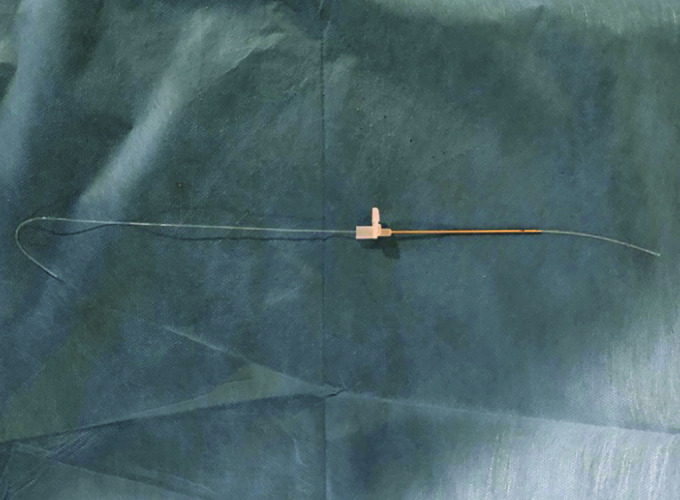Abstract
How to cite this article: Srinivasan A, Naidu V, Dhivya P. Arterial Line Placement Using Modified Seldinger Technique: A Novel Approach. Indian J Crit Care Med 2023;27(7):515–516.
Keywords: Arterial cannulation, Seldinger technique, Vascular access device
Dear Editor,
Arterial cannulation plays a crucial role in managing sick patients in both perioperative and intensive care settings. Arterial lines are utilized for continuous ‘beat-to-beat’ BP monitoring, when non-invasive blood pressure monitoring is impractical, when frequent arterial blood sampling is required, and for advanced hemodynamic monitoring.1 The radial artery is the most commonly used site for establishing an arterial line due to its consistent anatomic accessibility, relative ease of cannulation, and low rate of complications. The palpation-guided technique is often used with a good success rate in the hands of an experienced intensivist.2
However, there are times when using the palpation-guided technique can become technically difficult in that subset of patients with edema, obesity, or hypotension. This may lead to multiple attempts in securing the line. This, in turn, may lead to hematoma formation or arterial spasms which would render the artery unusable and unsalvageable. Moreover, difficult arterial line placements have proven to be a significant contributor to reduced operating room efficiency due to procedural time delays and may have a negative impact on patient outcomes.3 This problem could be mitigated to an extent by using an ultrasound-guided approach.4 However, an ultrasound machine dedicated to the purposes of vascular access will not be available at several low-cost medical setups.
Another way to rectify this potential issue of securing a radial arterial line is by opting to use Seldinger's technique instead. Multiple studies have shown that using a direct Seldinger's guide wire-assisted technique yields better results in salvaging as well as establishing an arterial line with the reduced number of attempts and minimal complications.4,5 Dedicated arterial cannulas make use of this technique and are commercially available. However, these cannulas are expensive and not feasible in low-cost settings. Hence, the go-to device is the cheaper and more widely available peripheral intravenous cannula.1
Smaller size Foleys catheter comes with a guide wire which is routinely used for certain urological and gynecological procedures. This is utilized when a smaller size Foley's urinary catheter is required to be inserted in patients with a potential obstruction of the lower urinary tract (Fig. 1).6 This guide wire can be freely passed through the style of an appropriately sized intra-venous cannula (Fig. 2). The length of the guide wire is more than sufficient for the purpose of cannulating the radial artery. Moreover, the blunt tip of the guide wire will be atraumatic to the vessel wall and sterility can also be maintained. Hence, modified Seldinger's technique could be utilized with an intra-venous cannula to establish radial arterial lines in low-cost settings and could reduce the complications associated with repeated attempts at securing an arterial line. However, further studies are required to assess the success rate and feasibility of using this technique.
Fig. 1.

Size 10 Fr Foley's catheter and guide wire
Fig. 2.

Guide wire passed through stylet of 20 Gauge intra-venous cannula
Orcid
Arunkumaar Srinivasan https://orcid.org/0000-0002-4320-3794
Vishnu Naidu https://orcid.org/0000-0002-0413-7384
Ponnusamy Dhivya https://orcid.org/0000-0001-5241-1504
Footnotes
Source of support: Nil
Conflict of interest: None
References
- 1.Kaushal A, Bindra A, Singh S, Saeed Z. Modification of intravenous cannula for arterial line insertion: Simple yet effective technique. Indian J Anaesth. 2018;62(5):397–399. doi: 10.4103/ija.IJA_184_18. [DOI] [PMC free article] [PubMed] [Google Scholar]
- 2.Saugel B, Kouz K, Meidert AS, Schulte-Uentrop L, Romagnoli S. How to measure blood pressure using an arterial catheter: A systematic 5-step approach. Crit Care. 2020;24(1):172. doi: 10.1186/s13054-020-02859-w. [DOI] [PMC free article] [PubMed] [Google Scholar]
- 3.Scheer B, Perel A, Pfeiffer UJ. Clinical review: Complications and risk factors of peripheral arterial catheters used for haemodynamic monitoring in anaesthesia and intensive care medicine. Crit Care. 2002;6(3):199–204. doi: 10.1186/cc1489. [DOI] [PMC free article] [PubMed] [Google Scholar]
- 4.Peters C, Schwarz SKW, Yarnold CH, Kojic K, Kojic S, Head SJ. Ultrasound guidance versus direct palpation for radial artery catheterization by expert operators: A randomized trial among Canadian cardiac anesthesiologists. Can J Anaesth. 2015;62(11):1161–1168. doi: 10.1007/s12630-015-0426-8. [DOI] [PubMed] [Google Scholar]
- 5.Mangar D, Thrush DN, Connell GR, Downs JB. Direct or modified Seldinger guide wire-directed technique for arterial catheter insertion. Anesth Analg. 1993;76(4):714–717. 8466006 [PubMed] [Google Scholar]
- 6.He Pame, Song S, Chen Z, Liu Y, Zhou Z, Wang Y. Comparative study of wire-integrated urethral catheter versus wire-assisted urethral catheter in difficult male urethral catheterization: A single-center experience. Transl Androl Urol. 2019;8(6):736–740. doi: 10.21037/tau.2019.12.04. [DOI] [PMC free article] [PubMed] [Google Scholar]


